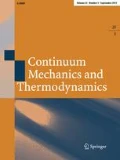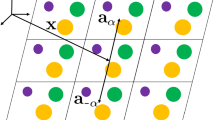Abstract
In the paper, we deal with ballistic heat transport in a graphene lattice subjected to a point heat source. It is assumed that a graphene sheet is suspended under tension in a viscous gas. We use the model of a harmonic polyatomic (more exactly diatomic) lattice performing out-of-plane motions. The dynamics of the lattice is described by an infinite system of stochastic ordinary differential equations with white noise in the right-hand side, which models the point heat source. On the basis of the previous analytical unsteady analysis, an analytical formula in continuum approximation is suggested, which allows one to describe a steady-state kinetic temperature distribution in the graphene lattice in continuum approximation. The obtained solution is in a good agreement with numerical results obtained for the discrete system everywhere excepting a neighbourhood of six singular rays with the origin at the heat source location. The continuum solution becomes singular at these rays, unlike the discrete one, which appears to be localized in a certain sense along the rays. The factors, which cause such a directional localization and the mismatch between the continuum and discrete solutions, are discussed. We expect that the suggested formula is applicable for various damped polyatomic lattices where all particles have equal masses in the case of universal for all particles external viscosity.








Similar content being viewed by others
Notes
To describe such sources, one needs to formulate a problem for a system of stochastic ordinary differential equations.
\(a\simeq 0.142\) nm for real graphene lattice [35].
Everywhere, excluding the singular rays in the case when the steady-state solution is considered, see Sect. 6.
Kuzkin actually considered a more general problem formulation: the external random excitation is not assumed to be equal for all particles in a cell (Eq. (3.16) generally is not assumed to be true), and the masses of the particles inside a cell are also not assumed to be equal.
Note that in the case of a primitive rhombic scalar lattice (in particular for a square lattice) the singular rays also exist and correspond to \(\alpha \in \left\{ -\frac{\pi }{2},0,\frac{\pi }{2}\right\} =0\), see [14].
Excluding the points, where \({{\mathbf {g}}}_\pm =\mathbf{0}\) and the corresponding direction is undefined, which are shown as the green boxes.
The non-stationary solution is almost vanishes outside the circle with radius \(g_{\mathrm {max}}t\) with centre at the point source location, where \(g_{\mathrm {max}}\simeq 0.897\omega _*a\) [30] is the maximum magnitude for the vectors \({{\mathbf {g}}}_\pm \).
References
Abdukadirov, S., Ayzenberg-Stepanenko, M., Osharovich, G.: Resonant waves and localization phenomena in lattices. Philos. Trans. Roy. Soc. A Math. Phys. Eng. Sci. 377(2156), 20190110 (2019). https://doi.org/10.1098/rsta.2019.0110
Ayzenberg-Stepanenko, M., Slepyan, L.: Resonant-frequency primitive waveforms and star waves in lattices. J. Sound Vib. 313(3), 812–821 (2008). https://doi.org/10.1016/j.jsv.2007.11.047
Bae, M.H., Li, Z., Aksamija, Z., Martin, P., Xiong, F., Ong, Z.Y., Knezevic, I., Pop, E.: Ballistic to diffusive crossover of heat flow in graphene ribbons. Nat. Commun. 4(1), 1734 (2013). https://doi.org/10.1038/ncomms2755
Berinskii, I., Borodich, F.: On the isotropic elastic properties of graphene crystal lattice. In: H. Altenbach, N. Morozov (eds.) Surface Effects in Solid Mechanics, Advanced Structured Materials, vol. 30, pp. 33–42. Springer, Berlin, Heidelberg (2013). https://doi.org/10.1007/978-3-642-35783-1_3
Berinskii, I., Kuzkin, V.A.: Equilibration of energies in a two-dimensional harmonic graphene lattice. Philos. Trans. Roy. Soc. A Math. Phys. Eng. Sci. 378(2162), 20190114 (2020). https://doi.org/10.1098/rsta.2019.0114
Dhar, A., Dandekar, R.: Heat transport and current fluctuations in harmonic crystals. Physica A 418, 49–64 (2015). https://doi.org/10.1016/j.physa.2014.06.002
Cython: C-extensions for Python. https://cython.org. Accessed 1 June 2021
Fedoryuk, M.: The Saddle-Point Method. Nauka, Moscow (1977). (In Russian)
Ferretti, M., Gavrilov, S.N., Eremeyev, V.A., Luongo, A.: Nonlinear planar modeling of massive taut strings travelled by a force-driven point-mass. Nonlinear Dyn. 97(4), 2201–2218 (2019). https://doi.org/10.1007/s11071-019-05117-z
Ferretti, M., Piccardo, G., dell’Isola, F., Luongo, A.: Dynamics of taut strings undergoing large changes of tension caused by a force-driven traveling mass. J. Sound Vib. 458, 320–333 (2019). https://doi.org/10.1016/j.jsv.2019.06.035
Fu, H.: Anisotropy affects the lattice waves and phonon distributions in GaAs. Eur. Phys. J. B 93(10), 199 (2020). https://doi.org/10.1140/epjb/e2020-10255-6
Gavrilov, S.: Nonlinear investigation of the possibility to exceed the critical speed by a load on a string. Acta Mech. 154, 47–60 (2002). https://doi.org/10.1007/BF01170698
Gavrilov, S.: Heat conduction in 1D harmonic crystal: discrete-to-continuum limit and slow-and-fast motions decoupling. arXiv:2006.08197 (2020)
Gavrilov, S., Krivtsov, A.: Steady-state kinetic temperature distribution in a two-dimensional square harmonic scalar lattice lying in a viscous environment and subjected to a point heat source. Cont. Mech. Thermodyn. 32(1), 41–61 (2020). https://doi.org/10.1007/s00161-019-00782-2
Gavrilov, S., Krivtsov, A., Tsvetkov, D.: Heat transfer in a one-dimensional harmonic crystal in a viscous environment subjected to an external heat supply. Cont. Mech. Thermodyn. 31, 255–272 (2019). https://doi.org/10.1007/s00161-018-0681-3
Gavrilov, S.N., Eremeyev, V.A., Piccardo, G., Luongo, A.: A revisitation of the paradox of discontinuous trajectory for a mass particle moving on a taut string. Nonlinear Dyn. 86(4), 2245–2260 (2016). https://doi.org/10.1007/s11071-016-3080-y
Gavrilov, S.N., Krivtsov, A.M.: Thermal equilibration in a one-dimensional damped harmonic crystal. Phys. Rev. E 100(2), 022117 (2019). https://doi.org/10.1103/PhysRevE.100.022117
Gel’fand, I., Shilov, G.: Generalized Functions. Volume I: Properties and Operations. Academic Press, New York (1964)
Giannoulis, J., Herrmann, M., Mielke, A.: Continuum descriptions for the dynamics in discrete lattices: derivation and justification. In: A. Mielke (ed.) Analysis, Modeling and Simulation of Multiscale Problems, pp. 435–466. Springer (2006). https://doi.org/10.1007/3-540-35657-6_16
Harris, L., Lukkarinen, J., Teufel, S., Theil, F.: Energy transport by acoustic modes of harmonic lattices. SIAM J. Math. Anal. 40(4), 1392–1418 (2008). https://doi.org/10.1137/070699184
Hemmer, P.: Dynamic and Stochastic Types of Motion in the Linear Chain. Norges tekniske høgskole, Trondheim (1959)
Ishibashi, Y., Iwata, M.: Dispersion relations near the conical point in some hexagonal lattices. Ferroelectrics 459(1), 107–111 (2014). https://doi.org/10.1080/00150193.2013.849172
Klein, G., Prigogine, I.: Sur la mecanique statistique des phenomenes irreversibles III. Physica 19(1–12), 1053–1071 (1953). https://doi.org/10.1016/S0031-8914(53)80120-5
Kosevich, A.: The Crystal Lattice: Phonons, Solitons, Dislocations, Superlattices. Wiley-VCH, Berlin, New-York (2005). https://doi.org/10.1002/352760667X
Krivtsov, A.: Energy oscillations in a one-dimensional crystal. Doklady Phys. 59(9), 427–430 (2014). https://doi.org/10.1134/S1028335814090080
Krivtsov, A.: Heat transfer in infinite harmonic one-dimensional crystals. Doklady Phys. 60(9), 407–411 (2015). https://doi.org/10.1134/S1028335815090062
Kunin, I.: Elastic Media with Microstructure I: One-Dimensional Models. Springer-Verlag, Berlin Heidelberg (1982). https://doi.org/10.1007/978-3-642-81748-9
Kuptsov, L.: Einstein rule. In: Encyclopedia of Mathematics. EMS Press (2001). https://encyclopediaofmath.org/index.php?title=Einstein_rule. Accessed 1 June 2021
Kuzkin, V.: Thermal equilibration in infinite harmonic crystals. Cont. Mech. Thermodyn. 31(5), 1401–1423 (2019). https://doi.org/10.1007/s00161-019-00758-2
Kuzkin, V.: Unsteady ballistic heat transport in harmonic crystals with polyatomic unit cell. Cont. Mech. Thermodyn. 31(6), 1573–1599 (2019). https://doi.org/10.1007/s00161-019-00802-1
Kuzkin, V., Krivtsov, A.: Fast and slow thermal processes in harmonic scalar lattices. J. Phys. Conden. Matter 29(50), 505401 (2017). https://doi.org/10.1088/1361-648X/aa98eb
Lepri, S., Livi, R., Politi, A.: Thermal conduction in classical low-dimensional lattices. Phys. Rep. 377(1), 1–80 (2003). https://doi.org/10.1016/S0370-1573(02)00558-6
Maris, H.: Enhancement of heat pulses in crystals due to elastic anisotropy. J. Acoust. Soc. Am. 50, 812–818 (1971). https://doi.org/10.1121/1.1912705
Mielke, A.: Macroscopic behavior of microscopic oscillations in harmonic lattices via Wigner-Husimi transforms. Arch. Rat. Mech. Anal. 181(3), 401–448 (2006). https://doi.org/10.1007/s00205-005-0405-2
Nika, D., Balandin, A.: Phonons and thermal transport in graphene and graphene-based materials. Rep. Prog. Phys. 80(3), 036502 (2017). https://doi.org/10.1088/1361-6633/80/3/036502
Northrop, G., Wolfe, J.: Ballistic phonon imaging in solids—a new look at phonon focusing. Phys. Rev. Lett. 43(19), 1424–1427 (1979). https://doi.org/10.1103/PhysRevLett.43.1424
Northrop, G., Wolfe, J.: Ballistic phonon imaging in germanium. Phys. Rev. B 22(12), 6196–6212 (1980). https://doi.org/10.1103/PhysRevB.22.6196
Rieder, Z., Lebowitz, J., Lieb, E.: Properties of a harmonic crystal in a stationary nonequilibrium state. J. Math. Phys. 8(5), 1073–1078 (1967). https://doi.org/10.1063/1.1705319
Savin, A., Zolotarevskiy, V., Gendelman, O.: Normal heat conductivity in two-dimensional scalar lattices. Europhys. Lett. 113(2), 24003 (2016). https://doi.org/10.1209/0295-5075/113/24003
Scuracchio, P., Costamagna, S., Peeters, F., Dobry, A.: Role of atomic vacancies and boundary conditions on ballistic thermal transport in graphene nanoribbons. Phys. Rev. B 90(3), 035429 (2014). https://doi.org/10.1103/PhysRevB.90.035429
Serov, A., Ong, Z.Y., Pop, E.: Effect of grain boundaries on thermal transport in graphene. Appl. Phys. Lett. 102(3), 033104 (2013). https://doi.org/10.1063/1.4776667
Sfyris, D., Sfyris, G.I., Galiotis, C.: Curvature dependent surface energy for a free standing monolayer graphene: Some closed form solutions of the non-linear theory. Int. J. Non-Linear Mech. 67, 186–197 (2014). https://doi.org/10.1016/j.ijnonlinmec.2014.09.005
Sfyris, D., Sfyris, G.I., Galiotis, C.: Curvature dependent surface energy for free standing monolayer graphene: geometrical and material linearization with closed form solutions. Int. J. Eng. Sci. 85, 224–233 (2014). https://doi.org/10.1016/j.ijengsci.2014.08.007
Slepyan, L., Tsareva, O.: Energy flux for zero group velocity of the carrier wave. Sov. Phys. Doklady 32, 522–526 (1987)
Sokolov, A., Müller, W., Porubov, A., Gavrilov, S.: Heat conduction in 1D harmonic crystal: discrete and continuum approaches. Int. J. Heat Mass Transf. 176, 121442 (2021). https://doi.org/10.1016/j.ijheatmasstransfer.2021.121442
Stepanov, S.: Stochastic World. Springer, New York (2013). https://doi.org/10.1007/978-3-319-00071-8
Temme, N.: Asymptotic methods for integrals. World Sci. (2014). https://doi.org/10.1142/9195
Vladimirov, V.: Equations of Mathematical Physics. Marcel Dekker, New York (1971)
Wolfe, J.: Imaging Phonons: Acoustic Wave Propagation in Solids. Cambridge University Press (1998). https://doi.org/10.1017/CBO9780511665424
Xu, X., Pereira, L.C., Wang, Y., Wu, J., Zhang, K., Zhao, X., Bae, S., B., T., Xie, R., Thong, J., Hong, B., Loh, K., Donadio, D., Li, B., Özyilmaz, B.: Length-dependent thermal conductivity in suspended single-layer graphene. Nat. Commun. 5(1), 3689 (2014). https://doi.org/10.1038/ncomms4689
Zhilin, P.: Vectors and Second-Rank Tensors in Three-Dimensional Space. Nestor, Saint-Petersburg (2001) (in Russian)
Acknowledgements
The authors are grateful to A. T. Ivaschenko, V. A. Kuzkin, O. V. Gendelman, A. Politi, E. V. Shishkina, A. A. Sokolov for useful and stimulating discussions.
Author information
Authors and Affiliations
Corresponding author
Ethics declarations
This work is supported by Russian Science Support Foundation (Grant No. 21-11-00378).
Additional information
Communicated by Andreas Öchsner.
Publisher's Note
Springer Nature remains neutral with regard to jurisdictional claims in published maps and institutional affiliations.
Appendix A: The dispersion surfaces and the group velocities for graphene lattice
Appendix A: The dispersion surfaces and the group velocities for graphene lattice
Consider Eqs. (3.6) and (3.7) in the absence of dissipation (\(\eta =0\)) and of the noise term in the right-hand side (\(b_0=0\)):
Let
Provided that \(\omega \) satisfies the dispersion relations
the right-hand side of Eq. (A.2) is the solution of Eq. (A.1). Here
is the wave vector, \(\mathbf{b}^\gamma \) is the dual basis defined by Eq. (4.9).
The dispersion relations for graphene lattice are found in [1, 22, 29]:
The plot of the dispersion surfaces is shown in Fig. 9.
The vectors of the group velocities are
Here
is a characteristic speed.
Rights and permissions
About this article
Cite this article
Gavrilov, S.N., Krivtsov, A.M. Steady-state ballistic thermal transport associated with transversal motions in a damped graphene lattice subjected to a point heat source. Continuum Mech. Thermodyn. 34, 297–319 (2022). https://doi.org/10.1007/s00161-021-01059-3
Received:
Accepted:
Published:
Issue Date:
DOI: https://doi.org/10.1007/s00161-021-01059-3





